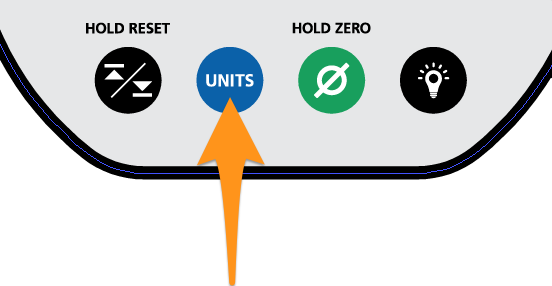Change Engineering Units on a Field Gauge LC10
Quickly switch between standard pressure and temperature engineering units, add or remove standard pressure engineering units, and add custom pressure engineering units to a Field Gauge.

Things you will need in order to change displayed units on a Field Gauge:
- A Ralston Instruments Field Gauge LC10.
Things you will need in order to Add or Remove engineering units to the Field Gauge.
- A PC running Windows.
- FieldLab Desktop software version 1.24 or later installed on your PC. Download the latest version for free.
- A Ralston Instruments LC10 Field Gauge.
- USB Cord, provided with your Field Gauge.
Change pressure or temperature engineering units displayed on Field Gauge.
1. Power on the Field Gauge
2. Tap the Units Button
Each time you tap the Units Button, the engineering units applied to the displayed pressure or temperature will change to the next available unit installed on your Field Gauge.

Add or Remove pressure engineering units on a Field Gauge.
1. Download and install the latest version of FieldLab Desktop, if you haven’t already.
You will need FieldLab Desktop version 1.24 or later.
2. Open FieldLab Desktop.
3. Connect Field Gauge to your computer with provided USB Cord.
4. Power on Field Gauge.
5. Select the Field Gauge you wish to administer on the Devices screen in FieldLab Desktop
6. Select the Settings Tab
7. In the Engineering Units module, select the button titled “Change”.
8. Add and/or remove pressure units from the Field Gauge as desired.
9. If you have created custom pressure engineering units in FieldLab Desktop, you can select up to two to add to the Field Gauge.
Field Gauge can hold two custom engineering units at a time.

10. When finished, select the button titled ‘Save Changes’ to update the settings on the Field Gauge.
Related Articles
Quick-Start Guide and User Manual for Field Gauge LC10
Download in PDF format below.Change Engineering Units on a Field Gauge LC20
Switch displayed pressure and temperature engineering units. 1. Press and Hold the Menu/Up Arrow Button. 2. Press the Backlight/Right Arrow Button to scroll to UNITS 3. Press the Zero/Check Mark Button to enter the Units submenu. The checkmark ...Installation instructions for panel-mounting a Process Meter LC30
1. Cut holes in panel using diagram 2. Position LC30 over holes 3. Insert bolts from front and install nuts loosely in back 4. Tighten nut until snug, but not too tight 5. Connect pressure / temperature connections 6. Connect power via approved power ...Change Engineering Units on a Process Meter
Switch displayed pressure and temperature engineering units. 1. Press and Hold the Menu/Up Arrow Button. 2. Press the Backlight/Right Arrow Button to scroll to UNITS 3. Press the Zero/Check Mark Button to enter the Units submenu. The checkmark ...Calibrate the pressure sensor on a Field Gauge and Process Meter
Do-it-yourself instructions for calibrating a Ralston digital gauge with the free FieldLab Desktop software. At the end of this process, FieldLab Desktop will automatically make any necessary adjustments to bring your Ralston gauge to acceptable ...
Recent Articles
Troubleshoot USB Power Noise Causing Pressure Reading Drift on a Ralston Gauge
Problem Unexpected pressure reading changes on an Ralston LC gauge when connected via USB. Root Cause Electrical noise is introduced through a low-quality USB hub and power supply interference. Noise from switch-mode power supplies (SMPS) can travel ...Adjust Damping on your Ralston Gauge
Damping slows the visual updates of a pressure gauge’s reading. The goal is to minimize minor fluctuations of the pressure reading on the screen caused by subtle variations in pressure that may create unwanted visual noise. Ralston gauges are set to ...Register your Ralston Gauge
Register your Ralston gauge to access calibration certificates and install firmware updates. This article applies to: FieldLab, Field Gauge LC10, LC20, and Process Meter LC30, all models. Things you will need: A PC running Windows. FieldLab Desktop ...Look Up Lead Time and Pricing for a Ralston Product
Go to ralstoninst.com Sign in to your Ralston account Select "Look Up Pricing and Lead Time by Model Number" Enter the model number of the Ralston product View the search results For each model number in your search results, info will be provided ...Download Current Price List
Get current pricing for all Ralston products Price lists are available in PDF, XLS, and CSV formats. All file formats include the following fields: Product Family (e.g. "NPT Male Quick-test Adapters) Part Number (e.g. "QTHA-2MS1") Description MSRP ...



